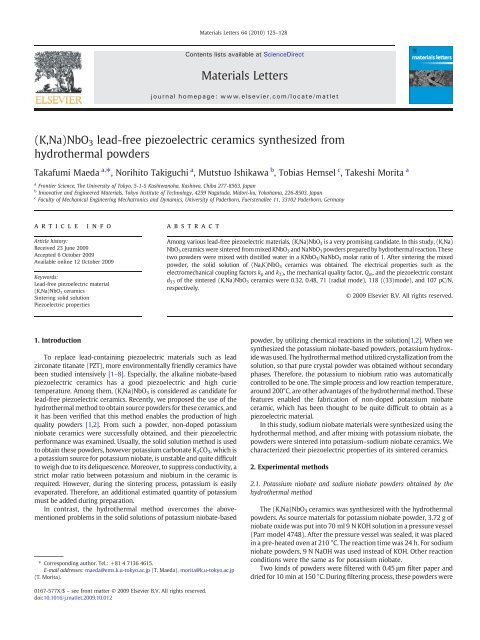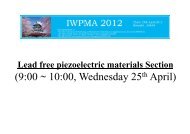(K,Na)NbO3 lead-free piezoelectric ceramics synthesized from ...
(K,Na)NbO3 lead-free piezoelectric ceramics synthesized from ...
(K,Na)NbO3 lead-free piezoelectric ceramics synthesized from ...
Create successful ePaper yourself
Turn your PDF publications into a flip-book with our unique Google optimized e-Paper software.
(K,<strong>Na</strong>)<strong>NbO3</strong> <strong>lead</strong>-<strong>free</strong> <strong>piezoelectric</strong> <strong>ceramics</strong> <strong>synthesized</strong> <strong>from</strong><br />
hydrothermal powders<br />
Takafumi Maeda a, ⁎, Norihito Takiguchi a , Mutstuo Ishikawa b , Tobias Hemsel c , Takeshi Morita a<br />
a Frontier Science, The University of Tokyo, 5-1-5 Kashiwanoha, Kashiwa, Chiba 277-8563, Japan<br />
b Innovative and Engineered Materials, Tokyo Institute of Technology, 4259 <strong>Na</strong>gatuda, Midori-ku, Yokohama, 226-8503, Japan<br />
c Faculty of Mechanical Engineering Mechatronics and Dynamics, University of Paderborn, Fuerstenallee 11, 33102 Paderborn, Germany<br />
article info<br />
Article history:<br />
Received 23 June 2009<br />
Accepted 6 October 2009<br />
Available online 12 October 2009<br />
Keywords:<br />
Lead-<strong>free</strong> <strong>piezoelectric</strong> material<br />
(K,<strong>Na</strong>)<strong>NbO3</strong> <strong>ceramics</strong><br />
Sintering solid solution<br />
Piezoelectric properties<br />
1. Introduction<br />
abstract<br />
To replace <strong>lead</strong>-containing <strong>piezoelectric</strong> materials such as <strong>lead</strong><br />
zirconate titanate (PZT), more environmentally friendly <strong>ceramics</strong> have<br />
been studied intensively [1–8]. Especially, the alkaline niobate-based<br />
<strong>piezoelectric</strong> <strong>ceramics</strong> has a good <strong>piezoelectric</strong> and high curie<br />
temperature. Among them, (K,<strong>Na</strong>)<strong>NbO3</strong> is considered as candidate for<br />
<strong>lead</strong>-<strong>free</strong> <strong>piezoelectric</strong> <strong>ceramics</strong>. Recently, we proposed the use of the<br />
hydrothermal method to obtain source powders for these <strong>ceramics</strong>, and<br />
it has been verified that this method enables the production of high<br />
quality powders [1,2]. From such a powder, non-doped potassium<br />
niobate <strong>ceramics</strong> were successfully obtained, and their <strong>piezoelectric</strong><br />
performance was examined. Usually, the solid solution method is used<br />
to obtain these powders, however potassium carbonate K2CO3, which is<br />
a potassium source for potassium niobate, is unstable and quite difficult<br />
to weigh due to its deliquescence. Moreover, to suppress conductivity, a<br />
strict molar ratio between potassium and niobium in the ceramic is<br />
required. However, during the sintering process, potassium is easily<br />
evaporated. Therefore, an additional estimated quantity of potassium<br />
must be added during preparation.<br />
In contrast, the hydrothermal method overcomes the abovementioned<br />
problems in the solid solutions of potassium niobate-based<br />
⁎ Corresponding author. Tel.: +81 4 7136 4615.<br />
E-mail addresses: maeda@ems.k.u-tokyo.ac.jp (T. Maeda), morita@k.u-tokyo.ac.jp<br />
(T. Morita).<br />
0167-577X/$ – see front matter © 2009 Elsevier B.V. All rights reserved.<br />
doi:10.1016/j.matlet.2009.10.012<br />
Materials Letters 64 (2010) 125–128<br />
Contents lists available at ScienceDirect<br />
Materials Letters<br />
journal homepage: www.elsevier.com/locate/matlet<br />
Among various <strong>lead</strong>-<strong>free</strong> <strong>piezoelectric</strong> materials, (K,<strong>Na</strong>)<strong>NbO3</strong> is a very promising candidate. In this study, (K,<strong>Na</strong>)<br />
<strong>NbO3</strong> <strong>ceramics</strong> were sintered <strong>from</strong> mixed K<strong>NbO3</strong> and <strong>Na</strong><strong>NbO3</strong> powders prepared by hydrothermal reaction. These<br />
two powders were mixed with distilled water in a K<strong>NbO3</strong>/<strong>Na</strong><strong>NbO3</strong> molar ratio of 1. After sintering the mixed<br />
powder, the solid solution of (<strong>Na</strong>,K)<strong>NbO3</strong> <strong>ceramics</strong> was obtained. The electrical properties such as the<br />
electromechanical coupling factors k p and k 33, the mechanical quality factor, Q m, and the <strong>piezoelectric</strong> constant<br />
d33 of the sintered (K,<strong>Na</strong>)<strong>NbO3</strong> <strong>ceramics</strong> were 0.32, 0.48, 71 (radial mode), 118 ((33)mode), and 107 pC/N,<br />
respectively.<br />
© 2009 Elsevier B.V. All rights reserved.<br />
powder, by utilizing chemical reactions in the solution[1,2]. When we<br />
<strong>synthesized</strong> the potassium niobate-based powders, potassium hydroxide<br />
was used. The hydrothermal method utilized crystallization <strong>from</strong> the<br />
solution, so that pure crystal powder was obtained without secondary<br />
phases. Therefore, the potassium to niobium ratio was automatically<br />
controlled to be one. The simple process and low reaction temperature,<br />
around 200°C, are other advantages of the hydrothermal method. These<br />
features enabled the fabrication of non-doped potassium niobate<br />
ceramic, which has been thought to be quite difficult to obtain as a<br />
<strong>piezoelectric</strong> material.<br />
In this study, sodium niobate materials were <strong>synthesized</strong> using the<br />
hydrothermal method, and after mixing with potassium niobate, the<br />
powders were sintered into potassium–sodium niobate <strong>ceramics</strong>. We<br />
characterized their <strong>piezoelectric</strong> properties of its sintered <strong>ceramics</strong>.<br />
2. Experimental methods<br />
2.1. Potassium niobate and sodium niobate powders obtained by the<br />
hydrothermal method<br />
The (K,<strong>Na</strong>)<strong>NbO3</strong> <strong>ceramics</strong> was <strong>synthesized</strong> with the hydrothermal<br />
powders. As source materials for potassium niobate powder, 3.72 g of<br />
niobate oxide was put into 70 ml 9 N KOH solution in a pressure vessel<br />
(Parr model 4748). After the pressure vessel was sealed, it was placed<br />
in a pre-heated oven at 210 °C. The reaction time was 24 h. For sodium<br />
niobate powders, 9 N <strong>Na</strong>OH was used instead of KOH. Other reaction<br />
conditions were the same as for potassium niobate.<br />
Two kinds of powders were filtered with 0.45 μm filter paper and<br />
dried for 10 min at 150 °C. During filtering process, these powders were
126 T. Maeda et al. / Materials Letters 64 (2010) 125–128<br />
washed sufficiently with 1 L of distilled water. Fig. 1 shows SEM<br />
photographs of the obtained powders. The powder sizes were<br />
approximately 1 μm for K<strong>NbO3</strong> and 3 μm for <strong>Na</strong><strong>NbO3</strong> powders,<br />
respectively. Fig. 2 shows an XRD pattern for each powder. From these<br />
results, it was confirmed that the powders had no impurity or secondary<br />
phases, such as niobium oxide or pyrochlore.<br />
Fig. 1. SEM of hydrothermally produced powder (a)KNbO 3 and (b) <strong>Na</strong>NbO 3.<br />
2.2. Sintering process<br />
Fig. 2. XRD patterns of hydrothermally produced powders: (a) KNbO 3 and (b) <strong>Na</strong>NbO 3.<br />
Fig. 3. XRD patterns: (a) powder mixtures and (b) (K,<strong>Na</strong>)NbO 3 ceramic.<br />
To synthesize (K,<strong>Na</strong>)<strong>NbO3</strong> <strong>ceramics</strong>, K<strong>NbO3</strong> and <strong>Na</strong><strong>NbO3</strong> powders<br />
were mixed in distilled water. The amounts were 1.500 g and 1.366 g,<br />
in order to obtain a molar ratio between potassium and sodium of 1 in<br />
the <strong>ceramics</strong>. The mixed powder was filtered and dried for 10 min at
Fig. 4. SEM of the surface of (K,<strong>Na</strong>)NbO 3 ceramic sintered at 1100 °C.<br />
150 °C. After drying, this powder was ground with alumina mortar<br />
and alumina pestle, and filtered with sieve (mesh size 425 μm). From<br />
this powder, a disk-shaped pellet was obtained using cold isostatic<br />
pressing (CIP) at 200 MPa. The pellet was then sintered at 1100 °C for<br />
two hours in an air environment. The heating rate was 230 °C/h and<br />
the cooling rate was 100 °C/h.<br />
Fig. 3 shows a comparison of XRD patterns between mixed powder<br />
and sintered <strong>ceramics</strong>. This figure indicates that in the sintering<br />
process, KNbO 3 and <strong>Na</strong>NbO 3 powders resulted in the solid solution of<br />
(K,<strong>Na</strong>)<strong>NbO3</strong>. Note that the three peaks around 22° of the powder XRD<br />
became two peaks after sintering. SEM photographs of the <strong>ceramics</strong><br />
verified that the grain size was 3~20 μm as shown in Fig. 4. The<br />
density of the sintered (K,<strong>Na</strong>)NbO 3 ceramic was measured to be<br />
4.09 ×10 3 kg/m 3 by density meter (Alfamirage SD-200 L), which<br />
corresponds to a relative density of 90.7%.<br />
2.3. Piezoelectric properties<br />
The samples were cut by diamond cutter (Musashino densi MPC-<br />
130) and polished with #2000 sandpaper into appropriate shapes for<br />
the determination of their <strong>piezoelectric</strong> properties in the radial and<br />
(33) modes. Gold electrodes were deposited on each side using a<br />
sputtering coater (Sanyu Electron: Quick Coater SG-701). The<br />
dimensions of the (K,<strong>Na</strong>)NbO 3 <strong>ceramics</strong> were ϕ6.6 mm×0.8 mm for<br />
the radial vibration mode and 4.3 mm×1.0 mm×0.7 mm for the (33)<br />
T. Maeda et al. / Materials Letters 64 (2010) 125–128<br />
mode. Poling treatments were carried out using a high voltage supply<br />
(Matsusada HARb-10P10) at 2.0 kV/mm in 100 °C silicone oil for<br />
30 min. The admittance results for the radial vibration mode and (33)<br />
mode are shown in Fig. 5(a) and (b). The electromechanical coupling<br />
factors kp and k33 were calculated <strong>from</strong> the resonant–antiresonant<br />
T<br />
method. The relative <strong>free</strong> permittivity ε33 was determined <strong>from</strong> the<br />
capacitance value at 1 kHz of the poled specimen. The stiffness cij<br />
E was<br />
calculated <strong>from</strong> the resonant frequency. With these parameters, the<br />
<strong>piezoelectric</strong> factors dij were calculated <strong>from</strong> the equation,<br />
d ij = k ij<br />
ffiffiffiffiffiffiffiffiffiffiffiffiffiffiffi<br />
εT 33 = cE q<br />
ij<br />
ð2:3:1Þ<br />
The measured <strong>piezoelectric</strong> properties of the (K,<strong>Na</strong>)<strong>NbO3</strong> <strong>ceramics</strong><br />
were as follows: the electromechanical coupling factors kp,andk33,the<br />
T E<br />
relative <strong>free</strong> permittivity ε33, the stiffness c33,<br />
the mechanical quality<br />
factor Qm, and the <strong>piezoelectric</strong> factor d33, were 0.32, 0.48, 264, 48 GPa,<br />
71 (radial mode), 118 ((33) mode), and 107 pC/N, respectively.<br />
3. Conclusion<br />
In this study, potassium niobate and sodium niobate powders were<br />
<strong>synthesized</strong> using a hydrothermal method. These two powders were<br />
sintered into a solid solution of (K,<strong>Na</strong>)NbO 3. This solid solution process<br />
was confirmed by XRD measurements. Compared to non-doped K<strong>NbO3</strong>,<br />
the poling process was easier [1,2]. The sintering temperature also<br />
became wider, <strong>from</strong> 1050 °C to 1150 °C. As a result, the <strong>piezoelectric</strong><br />
properties k 33=0.48, d 33=107 pC/N, and Q m=118 were obtained.<br />
Acknowledgements<br />
This research was supported by the New Energy and Industrial<br />
Technology Development Organization (NEDO). We would like to<br />
appreciate Dr. Daeyong Jeong for fruitful discussion.<br />
References<br />
[1] Ishikawa Mutsuo, Takiguchi Norihito, Hosaka Hiroshi, Morita Takeshi. Nondoped<br />
potassium niobate <strong>ceramics</strong> <strong>synthesized</strong> by hydrothermal method with optimum<br />
temperature condition. Jpn J Appl Phys 2008;47:3824–8.<br />
[2] Ishikawa Mutsuo, Kadota Yoichi, Takiguchi Norihito, Hosaka Hiroshi, Morita<br />
Takeshi. Synthesis of nondoped potassium niobate <strong>ceramics</strong> using ultrasonic<br />
assisted hydrothermal method. Jpn J Appl Phys 2008;47:7673–7.<br />
[3] Zhang Fan, Han Lu, Bai Shan, Sun Tiedong, Karaki Tomoaki, Adachi Masatoshi.<br />
Hydrothermal synthesis of (K,<strong>Na</strong>)<strong>NbO3</strong> particles. Jpn J Appl Phys 2008;47:7685–8.<br />
[4] Kumada N, Kyoda T, Yonesaki Y, Takei T, Kimura N. Preparation of KNbO 3 by<br />
hydrothermal reaction. Mater Res Bull 2007;42:1856–62.<br />
Fig. 5. Admittance characteristics of (a) the radial vibration mode and (b) the (33) vibration mode.<br />
127
128 T. Maeda et al. / Materials Letters 64 (2010) 125–128<br />
[5] <strong>Na</strong>kano Hiromi, Hirano Yousuke, Suyama Yoko. Microstructure of nano-porous<br />
<strong>Na</strong><strong>NbO3</strong> particles <strong>synthesized</strong> by sol-crystal method. Jpn J Soc Mater Sci 2007;56(6):<br />
500–4.<br />
[6] <strong>Na</strong>kamura Kiyoshi, Tokiwa Tsujiyoshi, Kawamura Yoshiko. Domain structures in<br />
KNbO 3 crystals and their <strong>piezoelectric</strong> properties. Jpn J Appl Phys 2002;91(11):<br />
9272–6.<br />
[7] Zhao Pei, Zhang Bo-Ping, Tu Rong, Goto Takahashi. High <strong>piezoelectric</strong> d 33 coefficient<br />
in Li/Ta/Sb-codoped <strong>lead</strong>-<strong>free</strong> (<strong>Na</strong>,K)<strong>NbO3</strong> <strong>ceramics</strong> sintered at optimal temperature.<br />
J Am Ceram Soc 2008;91:3078–81.<br />
[8] <strong>Na</strong>gata Hajime, Matsumoto Kenji, Hirosue Tadayuki, Hiruma Yuji, Takenaka<br />
Tadashi. Fabrication and electrical properties of potassium niobate ferroelectric<br />
<strong>ceramics</strong>. Jpn J Appl Phys 2007;46:7084–8.



